Mostly the signals out of a audio source is represented by Voltage/Time graph; like this -

Then how would the Current/Time graph would look like, and what will happen if we alter it?
Mostly the signals out of a audio source is represented by Voltage/Time graph; like this -

Then how would the Current/Time graph would look like, and what will happen if we alter it?
Then how would the Current/Time graph would look like
That depends on the circuit element the voltage is across. If the voltage in your graph is the voltage across a resistor, the current graph will have the same form since, for a resistor, the voltage and current are proportional.
$$i = \frac{v}{R}$$
If the voltage is across a capacitor, the current graph will be proportional the time derivative of the voltage waveform.
$$i = C\frac{dv}{dt} $$
If the voltage is across an inductor, the current graph will be proportional to the time integral of the voltage waveform.
$$i = \frac{1}{L}\int_\infty^t v(\tau) d\tau $$
If the voltage is across a diode, the current graph will be exponential in the voltage
$$i = I_S(e^{\frac{v_d}{nV_T}} -1)$$
And so on...
Ohms Law tells us that the current is proportional to voltage and inversely proportional to resistance. The resistance, in your example might be the input resistance of another amplifier and if so, the current waveform resulting would look exactly the same as the voltage waveform but scaled appropriately in amps or milli amps.
It gets a little more complex if the audio source is (say) a moving coil microphone or a guitar pick-up because the internal workings of these devices produce a more complex output impedance and, when connected to a load, the current waveform may get a little out of shape compared to the unloaded voltage waveform BUT, the loaded voltage waveform will also become misshapen by the loading effects in order to maintain ohms law for the loading resistor.
If the loading resistor is in fact a loudspeaker then there are other anomalies that creep in to "adjust" the shape of the waveform and because the speaker is a non-truly-resistive load, the current waveform will look a little bit different to the voltage waveform across the speaker.